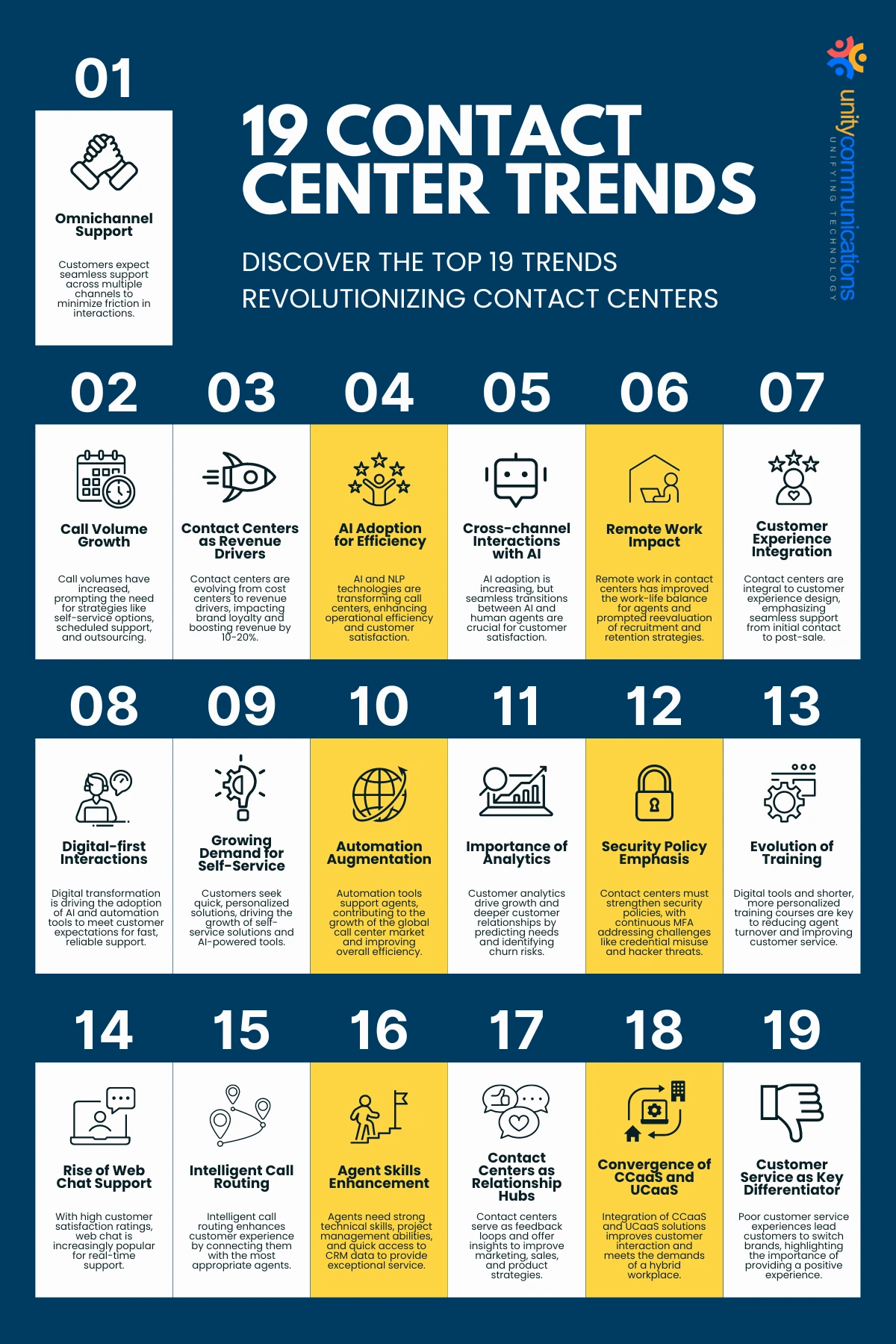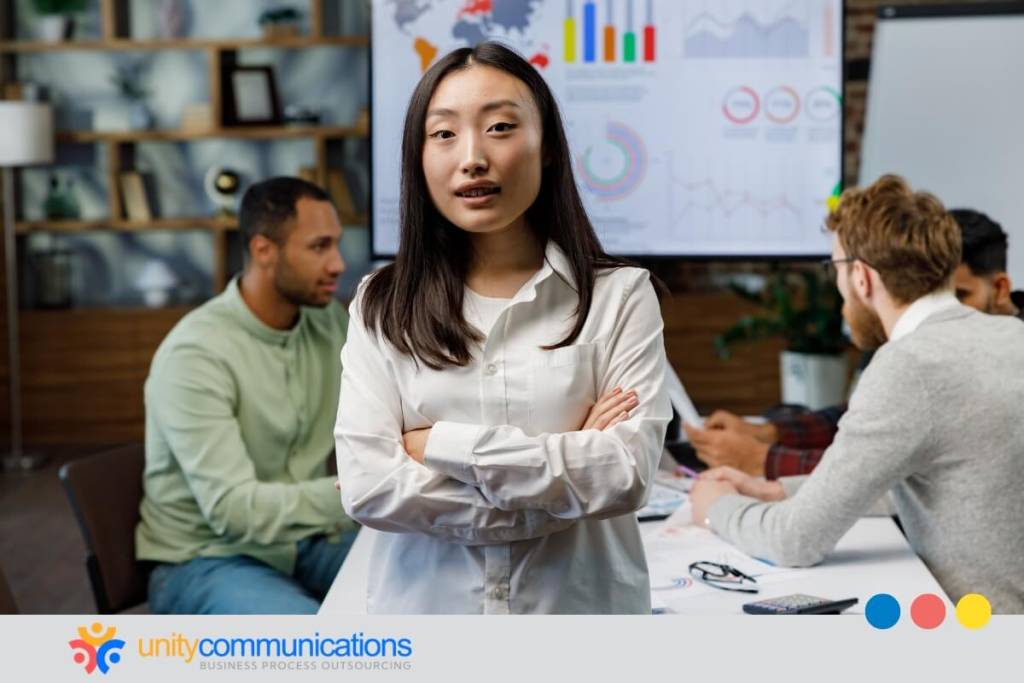Table of Contents
The contact center industry has seen substantial changes in recent years, transforming the customer experience landscape. The rise of virtual agents, cloud computing, and the implementation of artificial intelligence (AI) have become widespread, leading to the growth of contact center as a service (CCaaS).
In this guide to contact centers and call center trends, we aim to familiarize you with the latest trends and developments in the industry. Understanding these trends is essential for making informed decisions that can significantly enhance your customer service strategies. This guide will provide insights into the evolving dynamics of contact centers and how they are shaping the future of customer interactions.
19 Contact Center and Call Center Trends for 2025

Contact center hardware and software trends allowed support teams to reduce customer issues. In 2025, call centers must implement more advanced solutions, such as CCaaS solutions, to improve internal processes. Designing policies that reflect the current customer support landscape is another goal.
Here are 19 contact center trends to help you train agents, streamline processes, design experiences, and improve customer service.
1. Omnichannel Support Is the Standard of Customer Service
Expectations for customer support have changed. Call centers formerly delivered customer service over the phone, but new trends demand omnichannel support. Most consumers start their journey online. They browse your website, message you via social media, or email you.
Offering support across multiple channels is not enough because having to repeat information to multiple agents is customers’ biggest source of frustration. They expect to continue their support journey when representatives answer the phone, not start over. As a result, customers demand interconnected experiences across these platforms.
Give customers the best experience by minimizing friction when interacting across communication platforms.
2. Call Volume Is Growing, so Contact Centers Must Think Beyond Voice
According to a McKinsey study, 61% of call center managers say volumes have increased since the pandemic years of 2020 and 2021. Call volumes rose for 60% of businesses, and contact centers will become flexible knowledge and support hubs. AI will help people work smarter. Contact centers are changing rapidly, so businesses must adapt to stay competitive.
Contact centers can tackle soaring call volumes by decreasing the number of incoming calls. At the same time, they improve average handling time (AHT). Explore some strategies below.
- Boost self-service options with help center articles, a knowledge base, or answers to FAQs. Self-support empowers customers to solve their issues. Instead of relying on agents for every concern, they find solutions themselves.
- Provide a handoff to voice support when self-service is full. By offering a clear next step to talking to human agents, companies improve UX. Users can book a call at a time that works for both parties. The agent already has the context to improve first-call resolution and handle time.
- Move to a scheduled or outbound support model. With scheduled customer callbacks, daily call volume is easier to manage. Managers pair agents with clients without holding time. Moreover, agents feel less pressure and are not in as high demand.
- Use automation and AI for customers to receive automated preliminary questions through their preferred channel whenever they book a callback. AI analyzes the response, serves alternative solutions (help articles, links to knowledge bases), and potentially resolves issues. AI creates tickets for more complex issues.
- Strategically schedule agents to accommodate high rates of seasonal traffic. A few weeks of tracking call frequency is enough to trace a pattern. Scheduling more representatives during the heaviest call traffic helps you better manage tickets.
- Use an online scheduling platform for customers who want to book appointments. Letting customers set, check, and edit their appointments online reduces the number of calls agents receive.
- Outsource your contact center if your in-house team struggles to manage high call volumes. Consider outsourcing specific tickets, such as calls from clients wanting to book appointments.
Many businesses adopt strategies to shorten the queue. They reserve voice support for high-value and sensitive tickets.
These call center trends mean companies will reassess their support setups. Instead of hiring more agents, brands continue to explore easier-to-scale channels.
3. Contact Centers as Revenue Drivers
Contact centers are transforming from cost centers to key revenue drivers. A striking 97% of consumers, up from 87%, acknowledge the significant impact of contact centers on brand loyalty, particularly for high-value purchases. This interaction boosts consumer confidence in complex or expensive items.
Additionally, contact centers enhance revenue through strategies like cross-selling and upselling, offering service plans, or damage coverage after addressing customer needs. Business perspectives are shifting to emphasize customer service in revenue generation. They can potentially increase topline revenues by 10-20% using contact centers as revenue drivers.
4. Contact Centers Adopt AI To Boost Efficiency
AI and NLP are transforming call centers, replacing outdated IVR systems with more efficient, AI-driven solutions. These technologies understand customer queries and quickly direct them to the appropriate department, enhancing customer satisfaction and operational efficiency.
The global call center market, valued at $314.5 billion in 2022, is projected to reach $494.7 billion by 2023. The call center AI market is also growing rapidly, expected to rise from $1.9 billion in 2022 to $14.6 billion by 2032. This growth reflects a shift towards chat-based communication and omnichannel support, indicating AI’s increasing role in customer service.
5. Cross-channel Interactions Are AI’s Safety Net
The adoption of AI in business is growing, with 35% of businesses using AI and 90% of leading companies investing in it. However, only 14.6% have fully integrated AI into their operations, highlighting a gap between investment and deployment. AI use has doubled since 2017, but challenges in customer journey continuity persist.
Seamless cross-channel interactions are a safety net; customers can effortlessly switch to live agents when AI, like chatbots, falls short. This approach mitigates AI’s limitations and ensures customer satisfaction, emphasizing the importance of a balanced, client-controlled transition in the customer journey with AI.
6. Remote Work Has Allowed Agents To Control When and How They Work
The shift to remote work in contact centers has significantly impacted agents’ work-life balance. Historically, these high-stress environments suffered from high absenteeism and turnover. Remote work offers agents more control and flexibility, allowing them to choose employers with better pay, benefits, and work environments without relocating.
A Gartner study found that 75% of remote or hybrid workers want more flexibility, accelerated by the pandemic. Consequently, contact centers are reevaluating recruitment and retention strategies, improving work experiences, balancing workloads, and creating more predictable environments to retain and attract talent.
7. Customer Experience Design Will Consider Contact Centers
Contact centers are increasingly integral to customer experience design. Businesses are concentrating on integrating post-sale support into their customer journey because 73% of customers prioritize customer experience as a crucial factor in purchase decisions, according to Zendesk data.
Customers value the product, convenience, a welcoming atmosphere, and positive brand interactions. Over 50% of them would switch to a competitor after one bad experience, highlighting the importance of every interaction. Strong customer relationships and brand loyalty require a seamless experience from initial contact to post-sale support.
8. Digital-first Interactions Are Becoming the Norm
Digital-first interactions are becoming essential, with companies ramping up digital transformation. The Flexera 2023 Tech Spend Pulse report shows 73% of organizations increasing IT budgets amidst economic uncertainty, with a 68% rise in cloud-based solutions. This shift highlights the growing demand for AI, machine learning, and cybersecurity resources.
Complexity and speed make IT decision-making difficult, and 60% of companies worry about IT spending growth. Automated customer service is essential to meeting customer expectations for fast, reliable support, so digital-first strategies are crucial. 59% of businesses plan to use IoT diagnostics and computer vision AI.
9. Growing Demand for Self-service
The demand for self-service in customer service is rapidly growing, with consumers seeking quick, personalized solutions across multiple channels. The customer self-service software market is expanding significantly, projected to grow from $18.64 billion in 2024 to $24.70 billion in 2025 and expected to reach $50.68 billion by 2029 at a 23.6% CAGR.
Cost-effectiveness, customer expectations, and 24/7 service are driving this growth. AI-powered solutions, mobile apps, and voice-activated services are trends, with customer feedback and CRM integration improving them. These innovations make self-service essential to modern customer service.
10. Automation Tools Will Augment Call Centers
Automation tools are becoming essential in call centers, supporting rather than replacing agents. The global call center market is projected to grow from US$314.5 billion in 2022 to US$494.7 billion by 2030, at a 5.8% growth rate.
This expansion relies on AI-driven automation to boost efficiency and let agents handle complex customer interactions. Call center AI is expected to grow from $1.9 billion in 2022 to $14.6 billion in 2032, indicating a shift toward chat-based and omnichannel support. Automation is thus crucial to improving efficiency and the overall customer service experience.
11. Analytics Provide Important Insights
The increasing focus on customer analytics reshapes business interactions and customer understanding. According to the Zendesk Customer Experience Trends Report 2023, 67% of business leaders seek better organization and use of customer data to personalize experiences.
Customer analytics drives growth and deeper customer relationships by predicting customer needs and identifying churn risks to target retention and revenue. They provide insights into customer behavior, preferences, and needs, allowing a personalized experience. This then helps improve services, pricing, and marketing.
12. Ensuring Safety in Security Policies
With remote work on the rise, contact center security policies must be strong. Historically, only 11% of enterprise cloud users have deployed MFA, which is changing as security needs grow. Twosense highlights the shift towards continuous MFA powered by behavioral biometrics and machine learning, offering seamless, constant authentication.
Contact centers face challenges like credential misuse and hacker threats, exacerbated by high industry turnover. Continuous MFA addresses these issues by verifying user identities daily, ensuring a balance of security, efficiency, and compliance. Regular training in security and compliance remains crucial for agents.
13. Expanding Training Possibilities
Training contact center agents ensures customers get the best experience. However, the previous standard of full-day classroom-based training is no longer applicable in most call centers.
Moreover, classroom-based training is not as effective. According to RTPS, shorter training courses support long-term retention and increase focus by 80%. Hence, companies now use digital tools to improve training methodologies, such as:
- Gamification
- Highly personalized feedback
- Short bursts of micro-learning modules
- AI-driven training hypothetical scenarios
In addition to opportunities for self-paced training, these call center trends are key to reducing churn rates. Improved training significantly decreases agent turnover in an industry known for high attrition.
14. Web Chat Is Becoming an Increasingly Popular Support Channel
Customers want everything fast, including quick resolutions to problems. Furthermore, customers prefer real-time support, such as live chat over social media or email.
Shoppers are more likely to buy again from live chat support companies. That makes sense; embedded live chat means consumers remain in the flow instead of waiting for a reply, sending an email, or making a phone call.
Consumers also report having more positive experiences with completed live chat interactions. Zendesk research shows that live chat has 85% customer satisfaction ratings, second only to phone support.
15. Call Routing Technologies Find the Best Match
Matching customers with the appropriate agents has always been a call center trend. As a result, intelligent call routing is growing in popularity. It creates positive experiences as contact centers connect customers to the best agents.
Case-owner routing, or skill-based routing, underpins the matching process. Callers can also request a particular representative familiar with their history or issues.
This technology optimizes the overall experience. It is possible with a prioritized call list for agents, shorter customer wait times, and a higher chance of first contact resolution.
16. Customer Service Agents Are Becoming Super Agents
Customers are increasingly self-reliant and tech-savvy, leveraging user communities and forums to find answers. Only complicated problems, therefore, reach contact centers. Thus, agents should be ready to handle challenging issues and identify causes.
Agents also need strong project management abilities, analytical skills, and technical training. With such skills, they understand all product or service details. They must also be willing to adapt to changes in call center trends and technologies. Lastly, they must reference data in the CRM fast.
Companies enable agents to go beyond contact centers and consult with business experts. This helps solve difficult issues and boost first-call resolution.
The ability to quickly find available resources helps companies offer better customer service. Comprehensive skill sets and quick thinking let agents easily navigate contact center demands and offer exceptional service as well.
17. Contact Centers as Relationship Hubs
Contact center representatives are the first to know of problems and advise management. They are the conduit for information between consumers and the marketing, sales, and product departments. The relationship between contact centers and clients is the core of customer support.
Agents serve as a feedback loop and can offer insights to help the marketing, sales, and product teams.
Agent insights are crucial at every stage of business development. These underpin strategies are aimed at repeat buyers and advocates. These insights are also vital data points for product development and management.
18. CCaaS and UCaaS Converge Communication
The flexible work environment and the need to collaborate and connect are trends vital to call center success. The same goes for the rising focus on customer engagement. Thus, customized, integrated, personalized, and embedded solutions are crucial; they help fulfill the needs of today’s workplace.
Here are how merging CCaaS and unified communications as a service (UCaaS) solutions improve the experience for all parties:
- Incorporating many communications options engages clients on their preferred platforms, including live chat, messaging, and video.
- A single dashboard for all business apps gives contact center agents a better infrastructure.
The merging of CCaaS and UCaaS technologies helps businesses improve customer interaction because it addresses the demands of a hybrid workplace.
19. Customer Service Has Become the Key Differentiator
Customers expect a completely positive experience, so they have little patience when it is lacking. A Vonage Report revealed the following actions that push customers to their loyalty-breaking point:
- Overall frustration (52%). An annoying experience repeatedly happens while interacting with a brand or service provider.
- Communication dead ends (46%). A customer calls in. No agent or other support channel is available.
- Hello, human. (46%). A caller wants to speak to a human agent, but no option to connect to one is available.
- Stranded in self-help (46%). A self-help option does not solve the problem, but no option to receive other support or call an agent is available.
- Stuck in a waiting loop (44%). The wait time is too long when a customer calls in, but they have no option to request a callback.
- Sent in the wrong direction (38%). A client calls in and selects a number from the recorded list of options but gets connected to the wrong agent.
- AI roundabouts (38%). A customer has to repeat themselves to an agent after explaining the problem to a chatbot or another agent.
- No changing lanes (26%). A customer has no option to switch between communication platforms.
These actions make customers stop supporting a brand. Customers demand a positive experience and are more than happy to leave after poor service.
More and more companies have started competing based on customer service quality. They can no longer hide poor customer support. Each organization has an online footprint of its failures and successes for everyone to see.
Call Center and Contact Center Predictions

Legacy call center technology will remain the standard, including analytics capabilities and smart interactive voice response (IVR).
On the other hand, emerging technologies will alleviate overhead and put actionable data at agents’ fingertips. Such technologies are the internet of Things (IoT), robotic process automation (RPA), virtual and augmented reality (V/AR), and the metaverse.
Read on for a closer look at the contact center predictions for the coming years.
1. Mobile Is the Future of Customer Support Service
Call center trends show that mobile devices are growing in importance. Clients will most likely use them to contact you via social media, live chat, or email. Likewise, call center agents can use their mobile devices to help customers. Mobile functionality is a key recruitment and retention tool because it supports flexible work.
Businesses must optimize mobile functionality and integrate their CRM and contact centers. Customers often struggle to reference their order history and other data when calling via a mobile device. But agents have access to a client’s full review to anticipate their needs better and assist regardless of where they are.
CRM integrations and mobile functionality accommodate higher call traffic. They also expedite resolutions and improve customer satisfaction.
Key takeaways
|
2. Channel Preferences Will Change
WhatsApp, founded in 2009, now has 2.2 billion users. It’s one of the most used social messaging apps and a popular choice for customer service channels. Customers and businesses alike prefer using WhatsApp to create outstanding experiences.
How contact centers adapt to customers’ channel preferences will determine their success. For instance, younger consumers are notorious for switching channels. They keep moving across voice calls, email, web chat, and more. Keeping up with them while maintaining the interaction’s context is key to successful customer service.
Key Takeaways
|
3. Voice Biometrics Will Replace Security Questions
Many customers use their mothers’ maiden names as one of their security questions. However, call center trends show that voice biometrics will dominate the future, with a projected market reach of $$8,229.27 by 2031.
Replicating the human voice is more challenging than stealing a customer’s data. Voice biometrics analyze the intricacies of the human voice, from the shape or size of the mouth to the tension in the vocal cords.
Voice biometrics recognizes the unique qualities of each customer’s voice and helps to quickly confirm their identity. Using their unique voiceprints helps solve security problems.
Key takeaways
|
4. Internet of Things
The world is getting more interconnected as devices connect with other devices or people independently. It might significantly affect contact centers, allowing companies to offer preemptive service.
For example, if a patient’s heart monitor is overheating, it can automatically send a service request to the right people. Perhaps an air conditioning unit can self-diagnose and alert the manufacturer when a part needs fixing. That would take the user out of the equation altogether.
The implication is that consumer behavior will change. Instead of merely buying products, consumers will purchase items with built-in customer support. This will raise the stakes for companies to ensure that they’re getting customer service right.
Key takeaways
|
5. Robotic Process Automation
Many contact centers depend on legacy systems that are difficult to navigate and require agents to accomplish multiple steps, even for basic tasks. Such time demands will not work well with impatient customers.
Call center trends reveal that RPA will become the norm, and its market size is expected to grow at a compound annual growth rate (CAGR) of 39.9% from 2023 to 2030. RPA uses bots and AI to simplify software development, implementation, and management. Contact centers benefit from RPA with a streamlined workflow.
This starts when robots help new agents through training modules. They also help agents record key data from each interaction and offer real-time information, helping boost customer satisfaction.
Other benefits of RPA include:
- Reduced human error, shorter wait time, and more reliable customer service
- Higher agent satisfaction and engagement
- Freedom for agents to concentrate on more complex tickets or individually follow up with customers
Key takeaways
|
6. Metaverse and Virtual Reality
Despite popular perception, virtual reality is nothing new. Homeowners have used iterations of this technology to plan and measure their home projects. Alternatively, fun-seekers tap into VR for games, concerts, and virtual interactions with their favorite celebrities.
Call center trends to justify the place of augmented and virtual reality and the metaverse in the future of customer service. These technologies are game-changers for customer tickets requiring in-person experience.
Agents guide customers through a virtual product demo or tour. They also virtually offer technical support or arrange a meeting with other staff or clients. The rise of the industrial metaverse is also influencing contact center strategies, integrating advanced virtual environments to enhance customer interactions and support experiences.
Contact center managers can host virtual seminars or training and unite remote workers through VR. In addition to reducing expenditures and travel time, VA and AR introduce clients to new ways of interacting with brands, strengthening collaboration.
Key takeaways
|
The Bottom Line

Businesses must recognize the importance of contact centers and support agents, especially in maintaining customer relationships and driving client retention. These call center trends for 2025 show a fundamental shift in the role and overall value of customer support within businesses.
Shoppers are more than willing to walk away when they feel they are getting poor service. Meanwhile, remote work opens opportunities for agents to jump ship.
Companies should reframe how they look at contact centers and consider adopting processes and tools that enable them to work efficiently. Remember that contact centers can help drive revenue through contact with customers and through providing customer feedback to marketing and product development departments.




